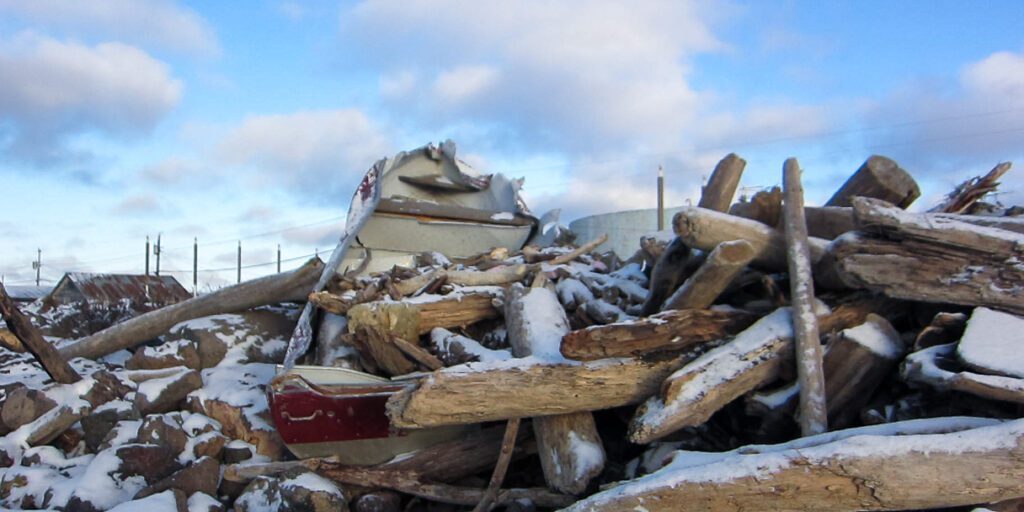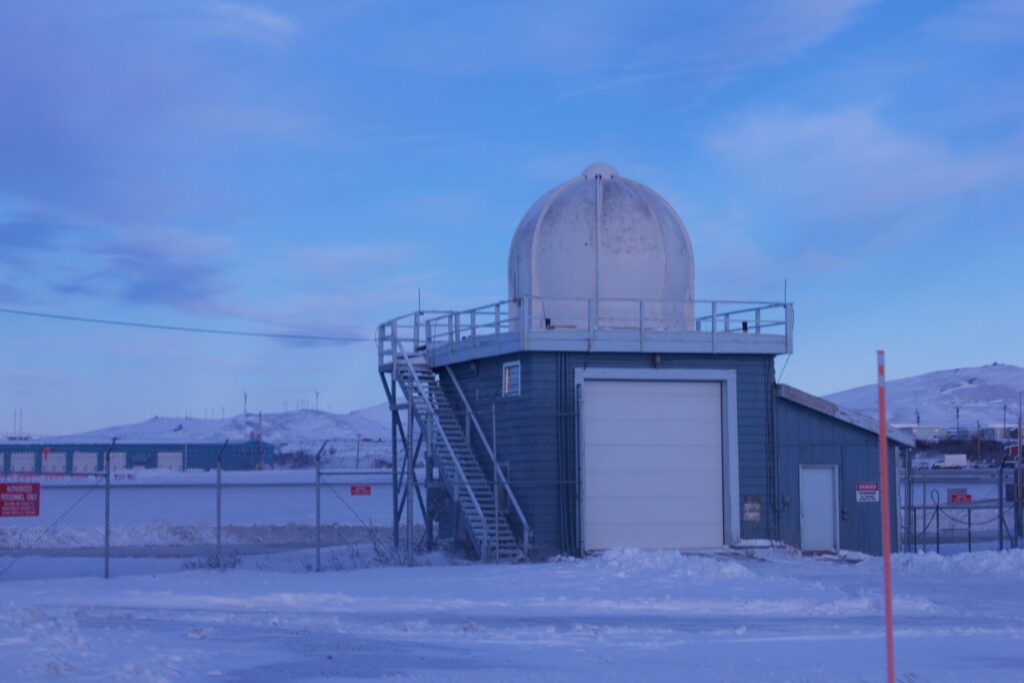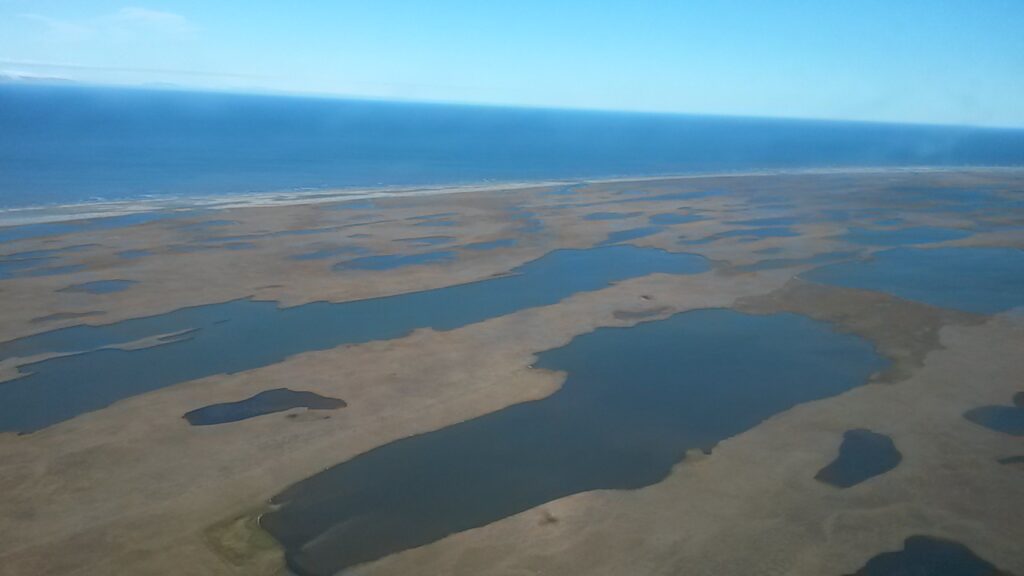On Tuesday I did the coolest work-thing I’ve done yet as a reporter with KNOM.
It was predicated on damage and misfortune, and left me mulling over questions about a paradox of reporting bad events in the news. In the process I also learned a more straightforward lesson about the value of snow-pants.
Within 24 hours of receiving a phone-call Monday afternoon, I was flying on a small plane into Stebbins with a handful of staff members from Kawerak (an important regional non-profit), state senator Donny Olson, and an Alaska representative from Homeland Security. Stebbins, like Kotlik and—to a lesser extent—Unalakleet, Shishmaref, Teller and Emmonak, was roughed up by bad storms two weeks ago. Unlike the other communities in the region, however, there was almost no information going in or out of Stebbins. The telecom installations were damaged amid destructive flooding that floated homes off their foundations and deposited fishing boats and driftwood atop the cemetery, among other places. In a town of a few hundred there was literally only one phone that worked for contacting state agencies and media to let people know what was happening.
Ours was a quick afternoon trip on a small chartered airplane. No press or politicians had been to Stebbins since the storm. By the time we left I had been covering the disastrous weather and clean-up efforts for a week-and-a-half, and knew next to nothing about what was going on there. Kawerak made the effort to bring personnel out because there needed to be an assessment about what was happening on the ground in the community. It felt extremely and vividly exciting to be participating in events of consequence in real time.
A piece of the trip that has stuck with me, but that I haven’t had much space to explore, is the hazy boundary between professional and personal experience in reporting on bad news. The fact of the matter is I get to visit events for work that are really, really exciting and interesting, but are rough, terrible, and unwanted for people who have to live through them. If I had to personally endure the same cold and scary last dozen days that folks in Stebbins have pulled through I am not clear how I’d have coped. It appears to take a strength I’ve never been called on to exercise. But professionally, it is unique to be a 24-year-old on the job less than three months and trusted with following someone as strong and capable as Melanie Bahnke, president of Kawerak, into a community recovering from a disaster. It’s cool to break a story on a big event—and immeasurably cooler to have done so after being in the place you’re reporting on, rather than over the office phone.
I had the same feeling while I was in Unalakleet two weeks ago—the same weekend the storm hit. I was covering a middle-school wrestling tournament when the storm rolled in, grounding flights, and keeping me there an extra night. Power cut out (and with it, heat), homes were flooded, ocean spray hurled over the sea walls, all while freezing gusts pushed water further and further up shore. It was intense, and at 2:15am as the storm was nearing its worst, I felt supremely grateful to be exactly where I was. It was the same troubling paradox: feeling good amid a bad thing. For people in Unalakleet there was nothing fun or adventurous about the imperiling of their homes, or the threats to the community’s well-being. For me—an outsider without property at risk, without a family to worry about, with enough food to last at least until planes started flying again—the stakes were low and the thrill high.
Even at a station with an inspirational mission like KNOM, news media thrives on calamity and catastrophe. One substantial bias in news reporting is that it feeds on break-down and dysfunction, as opposed to of continuity and upkeep. How many times has the front-page bore headlines along the lines of “Things Still Mostly Good: Electricity, Water, and Vital Supply Routes All Still In Good Working Order”? Never. And as a (volunteer) reporter, so far professional excitement over a story is pretty proportionate to the scale of a negative, fundamentally undesirable event. The bigger and bad-er the occurrence, the better its news value for circulating among media agencies, drawing in listeners, engendering encouragement in the form of “thank you for letting us know.” Bad news isn’t good: it’s great. Professionally, that is.
I do not think the muddy moral morass of bad-news-is-good-news negates the need for reportage from calamities. The gathering, packaging, and dispensation of information is, I believe, valuable, even if it’s not fully selfless. There was nothing in the press or public circulation about displaced families in Stebbins, about the need for heating units and cold weather gear, or the community’s resilience during the worst of the flooding. But to represent that work as completely altruistic would be dishonest. The professional benefit, the personal fulfillment—those are pieces of the complicated baggage that is worthy of humility, introspection, and pause. For those of us assembling information from data (i.e. any kind of journalist), there’s a perverse luck in malady. The tired adage about no news being good news swings backwards, too: good news is hardly news at all.
Malady and morality aside, a concrete take-away from my trip to Stebbins was the fundamental importance of snow-pants. It’s a lesson Eva DeLappe offered in a blog post last year, one I was too thick and proud to heed until getting a bodily education in True Cold. With wind-chill at -20 (pronounced: “twenty-below”) on the beach in Stebbins, long-underwear beneath jeans tucked into LL Bean boots were utterly impotent. After a temperate fall, Western Alaska is nestling into deepest winter. And though I felt chic and lithe heading to the airport sans snowpants, it only took a few raised eyebrows from Kawerak staffers and airport personnel to figure out that me and my slender legs looked dumb and fool-hearty. So, lesson learned, Alaska. Forgoing functional layers for the sake of sartorial habits makes you look foolish. Winter’s here ya’ll, time to get humble.







